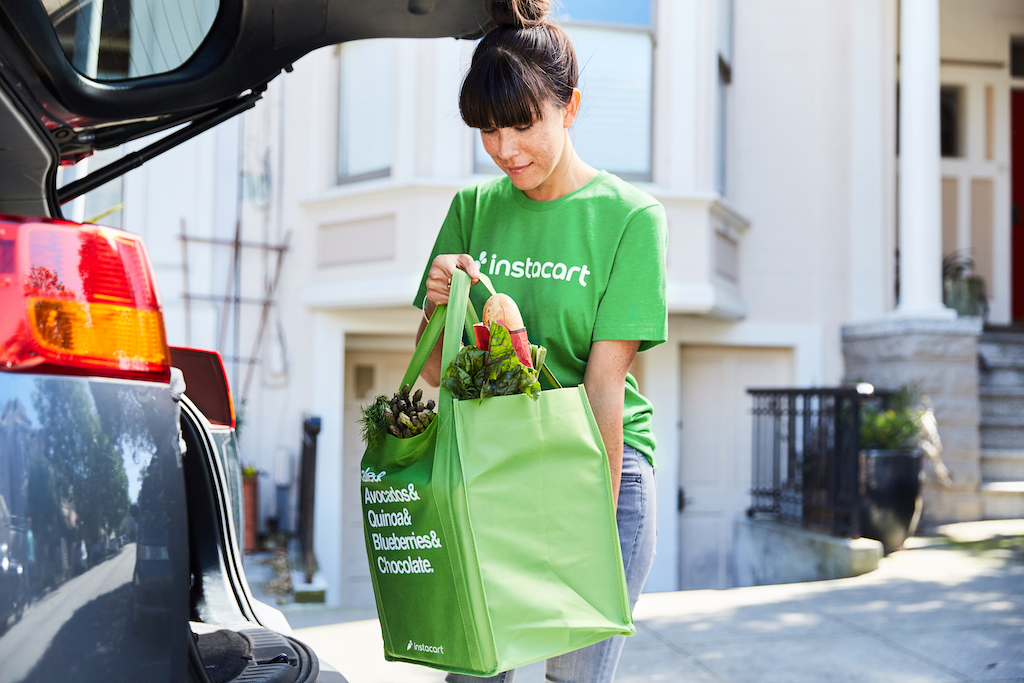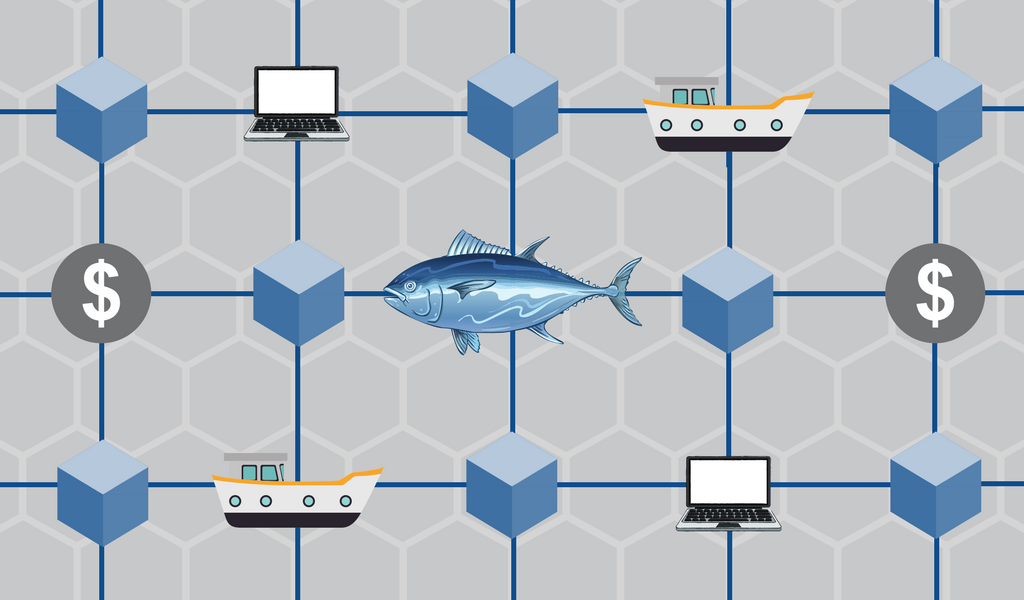
iStock / CSA-Printstock
The “internet of everything” (IoE) is coming to a grocery store near you. With a tap of your phone, you’ll be able to find out where your heritage pork was raised and your bluefin tuna caught—in theory.
IoE, for those of you just joining us, extends the “internet of things” (IoT) beyond “smart” internet-connected devices like home appliances, wearable tech, even vehicles, to everyday, disposable objects like a bottle of wine or a box of nutrition bars.
So, in the very near IoE future, your smartphone will be able to connect you to a web of other smart, internet-connected objects. Take the grocery store: In an IoE supermarket scenario, you might be shopping for tuna in the seafood section, and use your phone to scan a label on the packaging to find out the species, where it was caught it and by whom, where it was processed, and who distributed it. And if the seafood distributor had been tracking the fish on the blockchain, a theoretically immutable digital ledger, you could be assured that the information was true and unaltered.
 .
. Photograph by app2Photo / Graphic by NFE
Among the newest entrants to this supply-chain technology field is the Oslo, Norway-based Thin Film Electronics ASA—Thinfilm for short. In May, Thinfilm announced a new service for companies that will make the above “for instance” a reality. That kind of traceability may be good for business, but foodies interested in the provenance of their groceries may have to give up something in return: their privacy.
Founded in 2005, Thinfilm specializes in printed electronics. In the past few years, the company has launched several Near Field Communication (NFC) technology products. NFC is best known as the technology behind Apple Pay and other contactless payment systems, but Thinfilm has used the technology to create “smart tags” that can do things like monitor temperature or even track if and when a product has been opened, a technology they named OpenSense. The Spanish winery Barbadillo used Thinfilm’s tags for the special release of an ultra-luxury wine to commemorate the 125th anniversary of the birth of Manuel Barbadillo, a former president of the winery and son of its founder. Each of the 100 bottles of Amontillado Sherry had a label that—when tapped with a smartphone—could tell the drinker whether it had been opened previously. The bottles sold for £8,000 a pop.
Thinfilm had already been working on product authentication, so supply-chain tracking wasn’t a huge leap. Plenty of other companies are also working on blockchain-based technology for product traceability, including corporate giants Walmart and IBM. Even the World Wide Fund for Nature (WWF) has backed a project that would track tuna from “bait to plate” using RFID tags and QR codes. And last year, Cargill tracked Thanksgiving turkeys on the blockchain; buyers could enter a code online to find out where the bird was raised, see pictures, and read a message from the farmer.
However, blockchain technology is not without controversy, even in the food industry. The MIT Technology Review defines it as a public, permanent, append-only distributed ledger, characteristics that make for a nearly immutable record—a tantalizing possibility for anyone concerned about food traceability, authenticity, and provenance. However, many so-called blockchain applications fall outside of that definition, so the term is increasingly meaningless. Thinfilm’s offering runs on the Ethereum platform, which supports both public and private, or permissions-based, blockchain applications. (Nicholas Weaver, a researcher at the International Computer Science Institute at UC Berkeley, has dismissed private blockchains as “a 20-year-old technology that somehow causes idiots to throw money at it.”) In a previous article, I investigated whether the technology was the panacea for food safety that some claim it to be.
 Photo by Stock Catalog, graphic by NFE
Photo by Stock Catalog, graphic by NFE The above image depicts Bitcoin, a cryptocurrency whose transactions are traced using blockchain technology.
Thinfilm believes its edge over competitors is in its smart tags, which executives say are more attractive—practically invisible—than QR codes, and can be used for marketing purposes as well as tracking and authentication.
“Thinfilm is a company that’s really focused on what we call building the internet of everything,” says Matt Bright, Thinfilm’s senior director of product and technical Marketing. “That has two components, one is the physical component and one is the digital component.”
In the IoE world, you can have ‘smart’ bottles and boxes and even bags of produce. Anything you can affix a sticker to could theoretically take on a digital life in addition to the physical. However, as soon as someone touches their phone to a ‘smart’ label, the company that put it there begins learning things, too. “Behind the scenes, the brand has an opportunity to really understand their customer and where and when their customers are engaging and develop insights around that,” Bright says. After working with Thinfilm, a craft gin company in Finland was able to identify countries “where they previously didn’t realize they had loyal customers,” for example. Thinfilm also worked with a nutritional shake company to help it learn what time of day people were “engaging” with their meal replacement shakes—information that had been completely “opaque” previously—and to send customers targeted messages at breakfast and lunchtime.
This can all sound fairly benign, especially because as a society we have become accustomed to companies collecting mountains of data about us at all times. Sometimes, we’re willing participants in this information marketplace: Over the course of one weekend in 2014, hundreds of people gave away sensitive tidbits like their address, driver’s license number, phone number, or the last four digits of their social security number in exchange for a free cookie from a performance artist named Risa Puno. However, if these digital-physical objects become the norm, it will become increasingly difficult to opt out.
“The IoE [Internet of Everything] extends well beyond traditional IoT [Internet of Things] boundaries to include the countless everyday, disposable items in the world,” Thinfilm CEO Dr. Davor Sutija wrote in IoT Central last year. “If the IoT is the solar system, then the IoE is every galaxy in the universe.”
In marketing material, Thinfilm boasts that it can “link offline behavior to online profiles” and “bring the power of digital marketing to the physical world.” Every time a shopper taps to see where their olive oil came from, they give up another byte of information, another tidbit to add to their consumer profile.
And for what? Food traceability and authentication are not simple problems with simple solutions. “What most consumers don’t realize is that there are so many people along the supply chain who are handling or touching our food,” says Mitchell Weinberg, the founder of a food fraud detection and prevention firm called Inscatech, based in New York. “And the people who are adulterating the food and doing stuff to it, they’re very sophisticated in terms of concealing their crime. They don’t want to get caught, basically.”
A recent Associated Press investigation found that Sea To Table, one of the most highly-regarded seafood distributors, was passing off imported fish linked to labor and environmental abuses as locally-caught tuna, proving that even the good guys in a notoriously dirty industry can’t be trusted.
With solutions like Thinfilm’s, brands will choose what information is ultimately shared with buyers via smart tags, and you can be sure they’re only going to share the most flattering facts. It’s even conceivable that, like Sea To Table, they’ll try to lie or deceive consumers.
Thinfilm knows there is demand from shoppers for more information and transparency around food, and for brands that offer those insights, but perhaps not what a challenge delivering that information can be. Bright observes that “many supply chains are generally simple and generally trustworthy”—but if that’s true, then what’s the value in tracking items on the blockchain at all?
Other food companies have leveraged the blockchain for promotional purposes. Earlier this year, Oscar Mayer released a “cryptocurrency” called bacoin that most resembles a coupon or sweepstakes, like a “tap to play” contest Thinfilm ran with the Barbadillo winery last year. “Upon purchasing and opening a bottle, customers can retrieve a unique code printed on the cork and enter it in the field displayed on their smartphone—along with their name and other personal information—to instantly determine if they are a winner,” read a press release.
The bottom line? It’s all marketing.









